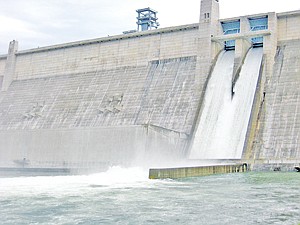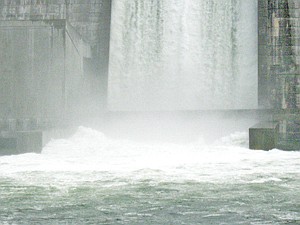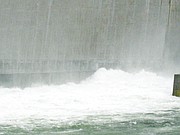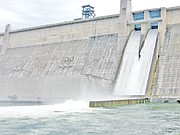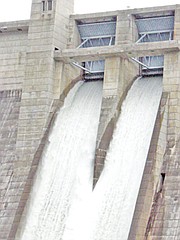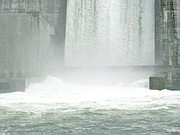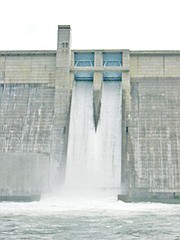Libby Dam reaching maximum pool; coping with record rain
The Western News | UPDATED 12 years, 6 months AGO
The U.S. Army Corps of Engineers has ramped up flows from Libby Dam even higher to prevent Lake Koocanusa from reaching full pool, but the higher flows continue to cause flooding at Bonners Ferry, Idaho.
The dam has been releasing water at powerhouse capacity of 25,000 cubic per second, but flows from its spillway and sluice gates were increased from 40,000 cfs to 46,000 cfs between Wednesday and Thursday. Inflows to Lake Koocanusa have been at 75,000 cfs for most of the week because of record June rainfall in the Kootenai River basin.
The reservoir has been rising by 1 to 1.5 feet per day and it was expected to continue doing so, with potential to reach the full pool elevation of 2,459 feet by Saturday.
“Once the final storage space behind Libby Dam is diminished, we will be forced to pass inflows to keep the reservoir from overfilling,” said Kevin Schaffer, a water manager for the Corps’ Seattle District.
“Raising outflows last night will slow the reservoir fill rate and allow river flows upstream and downstream of the dam to recede further before the remaining space in the reservoir is exhausted.”
The Kootenai River elevation at Bonners Ferry was 1,766 feet, about two feet above flood stage, and it could reach as high as 1,768 feet, according to the Corps, which is predicting the river could remain above flood stage until mid-July.
A Corps response team has been assisting Boundary County and Bonners Ferry city officials. Around 300 “super sack” sandbags were deployed along 500 feet of a levy that protects the nearby Kootenai River Inn Casino and Spa.
“There are no signs of any levees being breached,” said Tina Wilson, an acting public information officer for Boundary County. “In the low-lying ground behind the levees, there is ground seepage. That’s not unusual when the river is high.”
Some homes are surrounded by water, Wilson said, and some private roads are no longer accessible.
During flooding in 2006, when there was a similar spill emergency at Libby Dam, there was hundreds of thousands of dollars in damages, mostly to agricultural lands behind the levees. No monetary damage estimates have been calculated yet, Wilson said.
Record rainfall has soaked the basin in June. At Bonners Ferry, total precipitation for the month so far has been 5.2 inches, more than 300 percent of the June average of 1.66 inches. The previous record at Bonners Ferry was set in 1981 with 3.96 inches.
Some degree of spill has been under way for most of the month at Libby Dam, and that will have impacts on fish in the Kootenai River just below the dam, said Brian Marotz, a Montana Fish, Wildlife and Parks biologist who has long been involved in monitoring Libby Dam operations.
“I can tell you right now that we’re going to see a high incidence of gas bubble trauma in fish. Whether it’s lethal or not is the question,” Marotz said.
Dissolved gases created by the spillway releases can cause bubble-like sores on fish, particularly when there is an extended duration of spill. While most fish appeared to recover after past spill events, it is unknown if there are long-term impacts that might affect survival.
Fish that get gas bubbles on their eyes, for instance, might appear to recover when the bubbles go away. “But has it affected their vision?” Marotz said, noting that fish are sight-dependent feeders.
There are questions about whether gas bubble trauma causes secondary infections that may be lethal, and if there may long-term effects on reproductive systems, Marotz said.
Montana Fish, Wildlife and Parks will be spot monitoring for fish kills on the river, but Marotz said it’s important to consider that some fish are killed or injured when passing through the dam.
The state is in a “rear-guard position” because nothing can be done to stop the spill operation at Libby Dam, Marotz said. “We’re going to set out to learn as much as we can. There’s nothing else we can do about it.”
Northwest Montana’s Hungry Horse Dam, meanwhile, was releasing 500 cfs through its spillway, 7,000 cfs through its three jet valves and water through its generators for a total discharge of 17,300 cfs Wednesday, said Facility Manager Dennis Philmon.
The reservoir was just over its full pool elevation of 3,560 feet.
“We’re above it and that’s why we are spilling,” Philmon said.
However, inflows into the reservoir have been dropping so discharges from the dam could be curtailed by the middle of next week, he said.
The high flows on the South Fork Flathead River below the dam have contributed to the main stem Flathead River at Columbia Falls reaching minor flood stage Tuesday, but flows are expected to drop off over the next few days.



